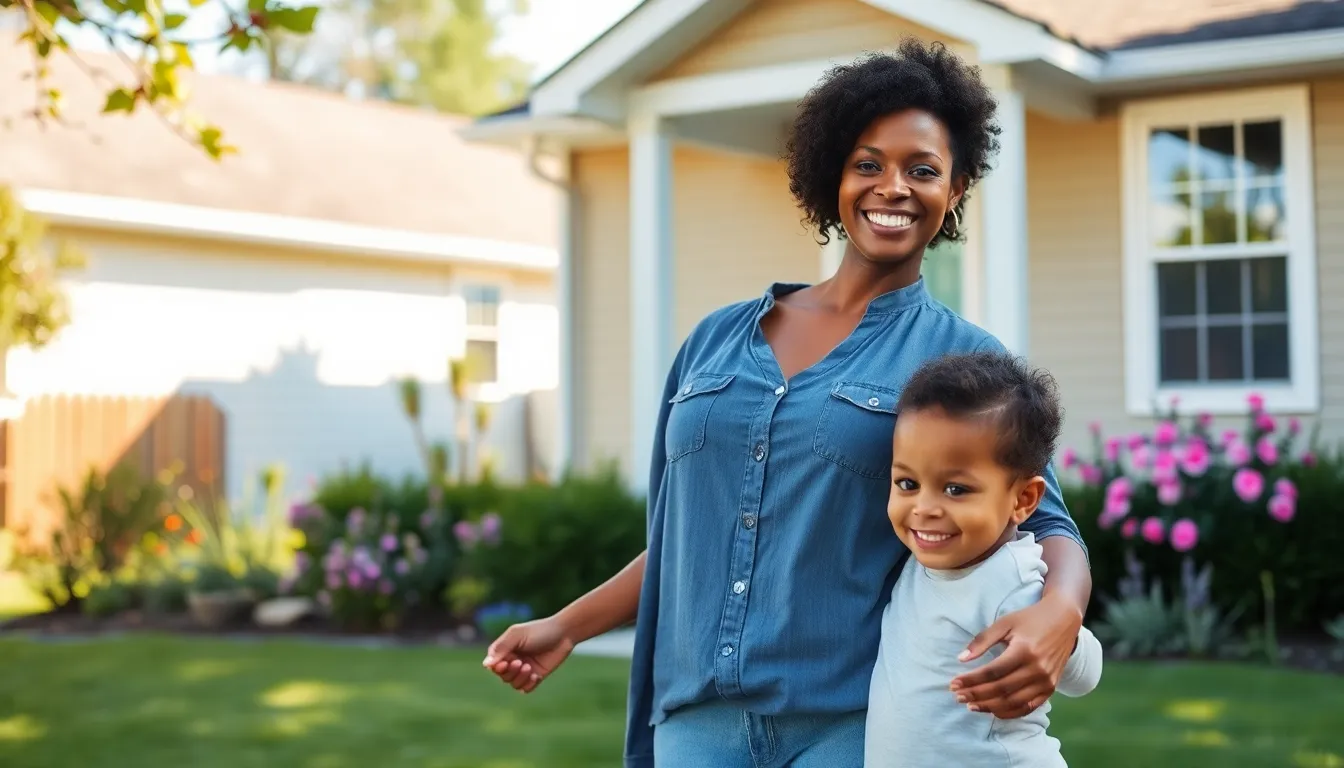Table of Contents
ToggleNavigating the world of homeownership can feel like trying to solve a Rubik’s Cube blindfolded—especially for single mothers juggling work, family, and the occasional superhero cape. But fear not! Down payment assistance programs are here to save the day. These initiatives offer financial support that can turn the dream of owning a home into a reality, without the need for a treasure map or a bank heist.
Imagine finally having a place to call your own, where you can kick off your shoes and let the kids run wild. With the right resources, single mothers can access funds that lighten the burden of hefty down payments. It’s time to explore how these programs can pave the way to a brighter future, one mortgage at a time.
Overview of Down Payment Assistance
Down payment assistance programs offer vital financial support for single mothers pursuing homeownership. These programs typically cover a portion of the down payment, making homes more affordable. Single mothers often face unique challenges, and these resources can help ease the burden of upfront costs.
Various types of assistance exist. Grants provide funds that do not require repayment, while second mortgages offer low-interest loans to cover down payment costs. Some programs allow for deferred payments until the homeowner refinances or sells the property.
Qualifying for down payment assistance usually involves meeting specific criteria. Applicants often need to demonstrate low to moderate income levels and complete homebuyer education courses. Many programs prioritize first-time homebuyers, ensuring that new homeowners understand the responsibilities of owning a home.
Local and state governments, as well as nonprofit organizations, administer these programs. Each entity may have different requirements and funding availability. Researching specific options in the target area can provide clarity on eligibility and assistance amounts.
Additionally, timing plays a crucial role in accessing these funds. Some programs offer limited funding, creating urgency for interested applicants. Staying informed about deadlines and availability increases the chances of receiving support.
Applying for down payment assistance can significantly impact single mothers’ ability to achieve lasting homeownership. By reducing financial barriers, these programs empower individuals to invest in stable, nurturing environments for their families.
Importance of Down Payment Assistance for Single Mothers

Down payment assistance plays a crucial role in helping single mothers achieve homeownership. Financial support from various programs significantly eases the burden of upfront costs.
Financial Challenges Faced by Single Mothers
Single mothers often face substantial financial challenges. These challenges include lower average incomes and increased expenses related to childcare and education. Many single mothers find it difficult to save enough for a down payment, leaving them at a disadvantage in the housing market. High living costs further exacerbate this issue, making it essential for them to explore available resources. Accessing down payment assistance can alleviate these financial constraints and create opportunities for homeownership that might otherwise remain out of reach.
Benefits of Homeownership
Homeownership provides numerous benefits to single mothers. Equity builds over time, offering financial stability and a long-term investment strategy. Stability in housing also promotes a secure environment for children, contributing to improved academic performance and emotional well-being. Additionally, many single mothers experience increased confidence and independence through owning their homes. A sense of community often develops as they engage with neighbors and local resources, further enhancing their quality of life. Accessing down payment assistance programs ultimately supports these advantages and fosters a brighter future for families.
Types of Down Payment Assistance Programs
Single mothers can benefit from various down payment assistance programs that significantly ease the path to homeownership. These programs fall into two main categories: federal programs and state or local initiatives.
Federal Programs
Federal programs often provide significant support. The FHA’s down payment assistance program allows qualified buyers to purchase homes with as little as 3.5% down. USDA loans offer zero down payment options in eligible rural areas, targeting individuals with low to moderate incomes. VA loans, available for veterans, also include provisions for no down payment. Other initiatives, such as the Good Neighbor Next Door program, aid teachers, police officers, and firefighters in purchasing homes at reduced prices. These federal programs generally have stringent eligibility criteria, but they aim to increase homeownership accessibility.
State and Local Programs
State and local programs also play a crucial role in down payment assistance. Many states offer grants that do not require repayment, while others provide low-interest loans to cover down payment expenses. Local housing authorities frequently administer such programs, tailoring support to meet community needs. For instance, some jurisdictions offer matching grants if applicants save a specific amount for their down payment. Eligibility usually hinges on income limits, home purchase price caps, and participation in homebuyer education courses. Each program varies in terms of funding availability and deadlines, creating a need for prospective buyers to act quickly.
Eligibility Requirements
Eligibility for down payment assistance programs varies, but a few key factors are often considered. Single mothers typically need to demonstrate their financial situation to qualify for these benefits.
Income Limitations
Income limitations play a crucial role in determining eligibility. Many programs target low to moderate income levels, often defined as 80% to 120% of the area median income. For instance, a single mother in a metropolitan area with a median income of $70,000 may need to earn between $56,000 and $84,000 to qualify for assistance. Programs evaluate applicants’ total household income, including income from all adult members living in the home. Often, local and state programs adjust income limits, so it’s essential to check specific eligibility criteria before applying.
Credit Score Considerations
Credit score considerations also impact eligibility for down payment assistance. Most programs require a minimum credit score, usually ranging from 580 to 620, to qualify. Higher credit scores may improve chances of receiving lower interest rates or more favorable loan terms. Lenders often evaluate payment history, outstanding debts, and overall credit utilization to assess financial stability. Single mothers should review their credit reports beforehand to identify and address potential issues, enhancing their likelihood of approval.
How to Apply for Down Payment Assistance
Applying for down payment assistance involves understanding the specific requirements of the chosen program. Single mothers should first identify available programs in their area, considering both federal and state or local options. Researching eligibility criteria and application deadlines ensures timely submission.
Application Process
Completing the application process begins with gathering relevant information about household income and employment. Applicants must fill out the respective forms provided by the program, which may include personal, financial, and property details. Responding accurately and thoroughly increases the chances of approval. Submitting the application usually occurs online or in-person, depending on program guidelines. Once submitted, monitoring application status and being prepared for follow-up requests will aid in staying informed.
Documentation Required
Documentation plays a critical role in the application for down payment assistance. Applicants typically need to provide proof of income, such as pay stubs or tax returns for the last two years. Additionally, bank statements demonstrating current savings can support the financial aspect of the application. Proof of enrollment in any required homebuyer education course often enhances the application. Lastly, including a valid government-issued ID ensures all personal identification information is accurate.
Success Stories
Single mothers across the country have successfully navigated the journey to homeownership, thanks to down payment assistance programs. For example, Maria, a single mother of two, accessed a grant through a local nonprofit. This grant covered her entire down payment, allowing her to purchase a home in a safe neighborhood.
Another case involves Jessica, who received assistance through a state program. She leveraged a low-interest second mortgage that eased her financial burden. By completing a homebuyer education course, she improved her financial literacy. This knowledge empowered her to manage her expenses better and ultimately secure stability for her family.
Local community stories also highlight the impact of these programs. A support group in a suburban area shared success tales of members who overcame financial hurdles. One participant, Chloe, highlighted that understanding application processes simplified her experience and led her to the right resources.
Numerous stories reflect the significant change in quality of life that comes with homeownership. Access to a stable home environment promotes children’s well-being, fostered by lower stress levels and increased involvement in the community. A single mother from an urban neighborhood stated that owning her home brought her family closer and created a nurturing space for her children.
In every instance, timely action proves crucial. Many single mothers who applied promptly benefited from available funding. Engaging with these programs not only reduces financial obstacles but also uplifts the spirits of families investing in their futures. Each success story embodies the strength and determination of single mothers committed to bettering their lives.
Down payment assistance programs offer vital support for single mothers striving for homeownership. By easing the financial burden of upfront costs these programs create pathways to stability and security. The transformative effect of owning a home can significantly enhance a family’s quality of life fostering a nurturing environment for children.
As single mothers navigate the complexities of applying for assistance they should remain proactive and informed. Understanding eligibility criteria and acting swiftly can make all the difference. With determination and the right resources single mothers can turn their homeownership dreams into reality paving the way for a brighter future.








